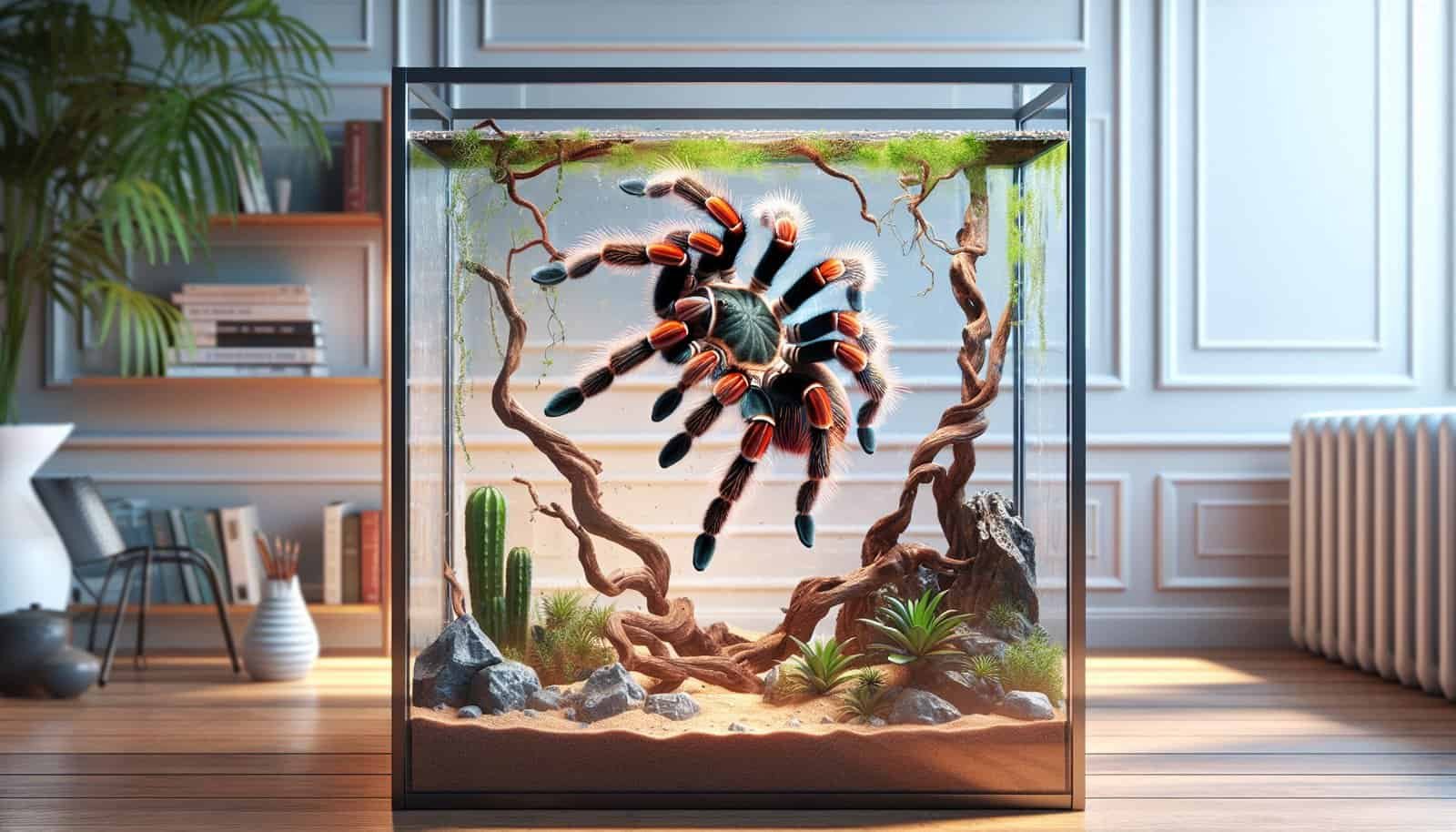Imagine the sight of a tarantula gracefully navigating its way up the walls of its enclosure, effortlessly utilizing every inch of vertical space. It’s a fascinating thought, isn’t it? But can tarantulas truly be kept in vertical enclosures specifically designed for climbing species? This article aims to explore the feasibility and benefits of providing such unique habitats for these creepy-crawlies and the important considerations that come with it. Get ready to uncover the secrets behind creating a spider’s perfect vertical playground!
Advantages of Vertical Enclosures
Simulates natural habitat
Vertical enclosures provide tarantulas with an environment that closely mirrors their natural habitat. In the wild, many tarantula species inhabit trees or other vertical surfaces, so a vertical enclosure allows them to feel more at home. This simulation of their natural environment can have a positive impact on their overall well-being and reduce the stress associated with captivity.
Allows for natural behaviors
Tarantulas are known for their ability to climb and maneuver vertically. By providing them with a vertical enclosure, you are allowing them to engage in natural behaviors such as climbing, web-building, and exploring their surroundings. This not only provides enrichment for the tarantula but also allows you to observe their natural behaviors more easily.
Provides more climbing opportunities
Vertical enclosures offer increased climbing opportunities for tarantulas compared to traditional horizontal setups. With more vertical space, tarantulas can explore and traverse various heights, creating a more engaging and dynamic environment. This extra climbing space can help to satisfy their natural instincts and promote their overall physical and mental well-being.
Considerations for Vertical Enclosures
Size and height requirements
When choosing a vertical enclosure for your tarantula, it is important to consider their size and the height requirements of their species. Larger tarantulas may require taller enclosures to accommodate their size and allow for adequate climbing space. Researching the specific needs and preferences of your tarantula species will help you choose an appropriate enclosure size and height.
Adequate ventilation
Proper ventilation is crucial in vertical enclosures to ensure a healthy and comfortable environment for the tarantula. Adequate airflow helps to prevent stagnant air, which can lead to respiratory issues and mold growth. Choosing an enclosure with ventilation holes or providing additional methods for airflow is essential for the well-being of your tarantula.
Suitable substrate
Selecting the right substrate for a vertical enclosure is important to ensure the tarantula’s safety and well-being. The substrate should provide a stable surface for climbing and burrowing, as well as retain moisture without becoming too soggy. A suitable substrate option for climbing species could be a mixture of peat moss and coconut fiber, which allows for burrowing and climbing while maintaining proper moisture levels.
Securing accessories and hiding spots
In a vertical enclosure, it is crucial to secure any accessories or hiding spots to prevent them from falling and potentially injuring your tarantula. Anchor points such as sticks or branches can provide extra climbing opportunities, but they must be securely attached and able to support the weight of the tarantula. Hiding spots should also be positioned securely to ensure they do not shift or collapse while the tarantula is using them.

Suitability of Tarantulas for Vertical Enclosures
Climbing species vs. terrestrial species
It is essential to differentiate between climbing species and terrestrial species when considering the suitability of tarantulas for vertical enclosures. While climbing species, like the Avicularia or Poecilotheria genus, thrive in vertical setups, terrestrial species such as the Grammostola or Brachypelma genus may not utilize the vertical space as much. Understanding the natural behaviors and habitat preferences of your specific tarantula species will help determine if a vertical enclosure is suitable for them.
Ability and preference for climbing
Some tarantula species are more adept climbers than others and have a natural inclination for vertical movement. These species will benefit greatly from being housed in a vertical enclosure that allows them to express their climbing abilities. Observing your tarantula’s behavior and researching specific species will help determine their natural inclination for climbing and guide you in making the appropriate enclosure choices.
Consideration of specific tarantula species
Different tarantula species have different needs and preferences when it comes to their enclosures. Some species may thrive in vertical setups, while others may prefer more horizontal spaces. Researching the specific tarantula species you intend to keep will provide valuable insights into their natural habitat and behaviors, allowing you to make informed decisions regarding their enclosure requirements.
Proper Design and Setup
Selection of appropriate enclosure
Choosing the right enclosure is crucial for the well-being of your tarantula. It should be spacious enough to accommodate the tarantula’s size and provide ample vertical space for climbing. Additionally, the enclosure should have secure lids or doors to prevent escapes and ensure the tarantula’s safety. Researching the specific needs of your tarantula species will guide you in selecting the most appropriate enclosure.
Vertical space utilization
When setting up a vertical enclosure, it is important to maximize the available vertical space. This can be achieved by providing various anchor points, such as branches or cork bark, at different heights. Vertical space utilization allows the tarantula to explore and climb freely, creating a more stimulating and natural environment for them.
Providing anchor points
Anchor points are essential in a vertical enclosure as they offer climbing opportunities and help create a more natural habitat. Sturdy branches, twisted vines, or cork bark can serve as anchor points, allowing the tarantula to climb and explore different heights and surfaces. Ensuring the anchor points are securely attached will prevent accidents and injuries.
Creating a natural environment
Incorporating natural elements in the enclosure design can enhance the tarantula’s well-being and simulate its natural habitat. Live plants, branches, rocks, and other natural decorations can create a more visually appealing and enriching environment. It is important to choose plants and decorations that are non-toxic to tarantulas and can be easily maintained within the enclosure.

Choosing the Right Enclosure
Different types of vertical enclosures
Vertical enclosures come in various forms, including glass terrariums, acrylic tanks, and customized mesh setups. It is important to consider the specific needs of your tarantula species when choosing the type of enclosure. Glass terrariums provide better visibility but may require additional ventilation, whereas acrylic tanks offer lightweight and durable options. Customized mesh setups can provide maximum airflow but may require more careful temperature and humidity regulation.
Suitability for tarantula size
The size of the enclosure must be appropriate for your tarantula’s species and individual size. Too small of an enclosure can lead to stress and limited movement, while too large of an enclosure can make it challenging for the tarantula to locate food and establish territories. Researching the size requirements of your specific tarantula species and providing an enclosure that allows for comfortable movement is essential.
Accessibility and maintenance
Considerations should be given to the ease of accessibility and maintenance when selecting a vertical enclosure. Having proper openings or removable lids will make it easier to access the enclosure for cleaning, feeding, and general care. Additionally, ensuring that the enclosure design allows for proper temperature and humidity regulation will contribute to the overall well-being of the tarantula.
Ventilation and Airflow
Ensuring proper airflow
Proper ventilation and airflow are crucial in vertical enclosures to maintain a healthy and comfortable environment for the tarantula. This can be achieved through ventilation holes, mesh screens, or fans that promote air circulation. Ensuring that the enclosure allows for fresh air exchange will help maintain optimal oxygen levels and prevent the buildup of harmful gases.
Preventing stagnant air
Stagnant air can be detrimental to a tarantula’s health, leading to respiratory issues and mold growth. It is important to design the enclosure in a way that promotes natural airflow and prevents air from becoming stagnant. Placing ventilation holes strategically throughout the enclosure and avoiding any obstructions to air circulation will contribute to a healthier environment.
Importance of ventilation holes
Ventilation holes are essential in vertical enclosures, as they allow for proper airflow and prevent the buildup of excess moisture. These holes should be appropriately sized to prevent escape while still allowing for effective airflow. Ensuring that the ventilation holes are positioned in a way that does not compromise the structural integrity of the enclosure is also crucial.

Substrate Selection
The importance of substrate
Choosing the right substrate is important for the tarantula’s comfort, as well as its ability to climb and burrow. A substrate that closely resembles their natural habitat allows the tarantula to engage in natural behaviors and maintain proper moisture levels. It should not be too compacted or loose, as this can hinder the tarantula’s movement and pose potential risks.
Selecting appropriate substrate for climbing
Climbing species of tarantulas require a substrate that facilitates climbing and burrowing. A mixture of peat moss and coconut fiber can provide a suitable substrate for climbing, as it is relatively loose and allows for easy movement and stability. Additionally, providing anchor points within the substrate, such as small pieces of cork bark, can enhance the climbing experience for the tarantula.
Avoiding compacted or loose substrates
Compacted or loose substrates should be avoided, as they can pose risks to the tarantula’s safety and hinder their natural behaviors. Compacted substrates may restrict movement and limit the tarantula’s ability to burrow, while loose substrates can create unstable climbing surfaces. Regular observation and maintenance of the substrate will help ensure a safe and suitable environment.
Securing Accessories and Hiding Spots
Using vertical structures
Vertical structures, such as branches or cork bark, can provide additional climbing opportunities and hiding spots within the enclosure. These structures should be securely attached to prevent any accidents or injuries. Placing them strategically within the enclosure will encourage the tarantula to explore and take advantage of the vertical space available.
Attaching anchor points securely
When incorporating anchor points, it is important to ensure they are securely attached to prevent them from falling or shifting. Using non-toxic adhesives, zip ties, or wire can help secure anchor points in place. Regular inspection of these attachments will ensure that they remain stable and provide a safe climbing experience for the tarantula.
Providing vertical hiding spots
Vertical enclosures should offer suitable hiding spots for the tarantula. These hiding spots can be provided through strategically placed cork bark tubes, hollowed-out branches, or other suitable materials. Hiding spots should be positioned securely and allow the tarantula easy access while still providing a sense of security and privacy.

Species-specific Considerations
Researching tarantula species
Researching your tarantula species is essential when considering their suitability for vertical enclosures. Each species has its own specific needs and behaviors that should be taken into account. Understanding their natural habitat, preferred microclimate, and climbing tendencies will help you create a suitable environment that promotes their well-being.
Understanding species’ natural habitat
Understanding the tarantula species’ natural habitat is crucial when designing their enclosure. Different tarantula species come from varying environments, such as tropical rainforests or arid deserts, each with their own specific temperature, humidity, and substrate requirements. Mimicking their natural habitat as closely as possible will contribute to their overall health and happiness.
Determining suitability for vertical enclosures
Not all tarantula species are suitable for vertical enclosures. Some species are primarily terrestrial, meaning they spend most of their time on the ground, while others are adept climbers. Understanding the natural behaviors and climbing tendencies of your specific tarantula species will help determine if a vertical enclosure is appropriate for them.
Monitoring and Care
Regular observations
Regular observation is crucial when keeping tarantulas in vertical enclosures. Monitoring their behavior, appetite, and overall well-being will help identify any potential issues or changes in their health. By observing their natural behaviors within the vertical enclosure, you can ensure that their needs are being met and make any necessary adjustments to their care.
Maintaining appropriate temperature and humidity
Maintaining appropriate temperature and humidity levels is essential for the well-being of tarantulas in vertical enclosures. Each species has its own specific temperature and humidity requirements that should be met to prevent stress or illness. Using thermometers and hygrometers to monitor and regulate these conditions will contribute to the overall health and comfort of your tarantula.
Feeding and watering considerations
Feeding and watering tarantulas in vertical enclosures may require additional considerations. Ensuring easy access to food and water sources is important, as well as regular maintenance of these sources to prevent contamination or spoilage. Observing the tarantula’s feeding response and adjusting feeding frequency or prey size accordingly will contribute to their overall health and nutrition.

